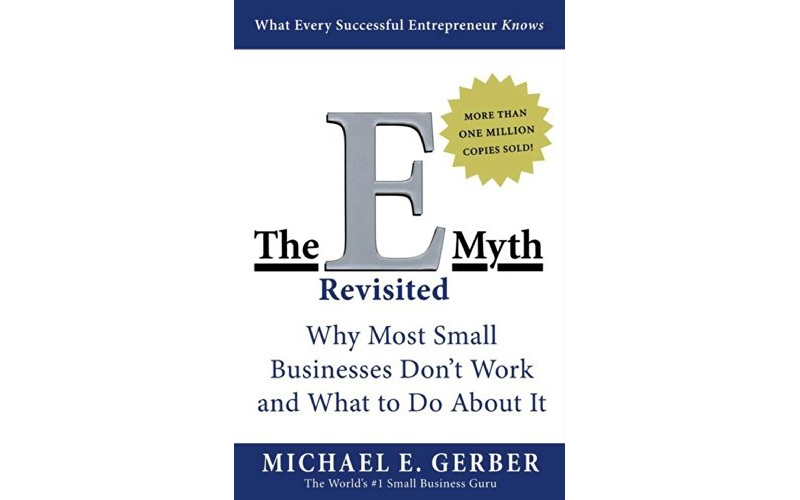A tactical book on the common reasons why businesses fail, and what to do about it.
Knowing how to do the work is a lot different from knowing how to run a business.
Everybody is a combination of 3 people: Technician, manager, entrepreneur. It’s knowing which one you need to be at certain times that’s the key.
It advocates setting up a business as if it were a franchise, being able to replicate and systemise everything.
The E-Myth Revisited (highlights)
People who are exceptionally good in business aren’t so because of what they know but because of their insatiable need to know more.
The mundane, tedious little things done right make a business great.
Business is a way to know ourselves. A mirror to what we know and how we act.
Just because you like baking pies doesn’t mean you should start a pie business. Knowing how to do the work is a lot different to knowing how to run a business.
Everybody who goes into business is 3 people in 1. Entrepreneur, manager and technician.
Entrepreneur. The dreamer. Lives in the future. People tend to get in the way of the dream. The energy. Innovator.
Manager. Pragmatic planner. Lives in the past and craves order.
Technician. The doer. Lives in the present. Likes space and time. Just wants to get into it.
An equal balance of this would be great. However, most people are 10% entrepreneur, 20% manager and 70% technician.
Business growth: Infancy, adolescence, maturity.
Infancy. You do all the work and are happy. You get more and more customers, busier and busier. You start to forget things and they start to fall apart. You get frustrated. Things need to change. Shut down or adolescence.
Adolescence. Begins when you decide to get help. Someone with experience. Then, management becomes abdication rather than delegation. You expect your first hire to do more and more, with no clear guidelines. Things fall apart, more quickly than before. You start to do things yourself again.
Maturity. Or you get small again, go back to infancy. Maturity is when you get out of your comfort zone and do the work and planning.
Plan your growth, with contingencies.
Start acting like the business you envision, that’s the only way to become it.
The E model doesn’t start with a picture of the business though, it starts with a picture of the customer and what problem it solves for them.
The world (customers) is a treasure hunt to the entrepreneur. To the technician the customer is an annoyance that gets in the way of work.
Sell the business (process/customer service) instead of the product.
Working on your business not in it. You don’t serve your business, your business serves you (and your customers).
Pretend you’re going to franchise your business and set it up that way.
Rely on systems, not people or experts.
Consistency and order says to a customer you know what you’re doing, and gives them comfort. They know what to expect when they come back.
Business development process: Innovation, qualification, orchestration.
‘What is the better way to do this?’
Innovation does new things, creativity thinks up new things.
Qualification-tracking.
Quantify everything related to your business. Then you can see the impact of innovation.
Orchestration – incorporating the improvement in the process so it’s standard.
Business development program:
1. Primary aim
2. Strategic objective
3. Organisational strategy
4. Management strategy
5. People strategy
6. Marketing strategy
7. Systems strategy
1. Primary aim
Is about you. What do you value? What would you want said at your funeral? Living intentionally or by accident. Keep this in perspective.
2. Strategic objective.
What we really want is to expand, grow and be more of ourselves. You can then turn to the business that’s going to help you get there. Strategic objective is clear statement of what your business has to do for you to achieve your primary aim. Means rather than an end.
List of standards:
• Money, profit – enough to fulfill your lifestyle
• Opportunity worth pursuing – fulfil your aim
• Other standards by answering questions – where, how, customer experience etc.
3. Organisational strategy
Organise around functions, not people or personalities. Replace yourself with a system. Keep replacing yourself.
4. Management strategy
Eliminating unpredictability with a system.
Getting it right for the customer every time. Actually listening and repeating the process.
Checklists and systems.
5. People strategy
Give them the idea behind the work that is more important than the work itself.
Playing a structured game rather than just ‘working’.
6. Marketing strategy.
Starts, ends, lives and dies with the customer.
What you want is unimportant, it’s what your customer wants that matters.
Demographics – who customer is. Psychographics – why they buy.
Find a ‘perceived’ need and fill it.
Listen to them, use their language when talking to them, find their perceived needs and problems and meet these needs, solve those problems.
7. Systems strategy
Hard systems. Unliving things.
Soft systems. Living, animate.
Info systems. Information.
A sales system is a soft system. 1. Appointment. 2. Needs analysis. 3. Solution.
Do we care enough about our values and priorities to make sure we stick to them?
Do we take them seriously enough? If so, build the systems to support them.
Business is creating a world of our own.
